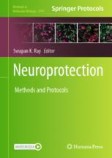Search
Search Results
-
MiR-17-5p Mediates the Effects of ACE2-Enriched Endothelial Progenitor Cell-Derived Exosomes on Ameliorating Cerebral Ischemic Injury in Aged Mice
Aging is one of the key mechanisms of vascular dysfunction and contributes to the initiation and progression of ischemic stroke (IS). Our previous...

-
Cerebral Vasoreactivity
Cerebral blood flow is mainly regulated by two mechanisms: cerebral autoregulation and neurovascular coupling (NVC). Cerebral autoregulation...
-
Cerebral Small Vessel Disease: a Review of the Pathophysiological Mechanisms
Cerebral small vessel disease (cSVD) refers to the age-dependent pathological processes involving the brain small vessels and leading to vascular...

-
Single-cell and bulk RNA-seq unveils the immune infiltration landscape associated with cuproptosis in cerebral cavernous malformations
BackgroundCerebral cavernous malformations (CCMs) are vascular abnormalities associated with deregulated angiogenesis. Their pathogenesis and optimal...

-
Effect of TDP43-CTFs35 on Brain Endothelial Cell Functions in Cerebral Ischemic Injury
Pathological changes in the brain endothelium play an important role in the progression of ischemic stroke and the compromised BBB under ischemic...

-
A transcriptomic analysis of cerebral microvessels reveals the involvement of Notch1 signaling in endothelial mitochondrial-dysfunction-dependent BBB disruption
BackgroundEndothelial cells (ECs) in cerebral vessels are considered the primary targets in acute hemorrhagic brain injuries. EC dysfunction can...

-
Single-Cell Transcriptome Reveals Cell Type–Specific Molecular Pathology in a 2VO Cerebral Ischemic Mouse Model
Post-ischemia memory impairment is a major sequela in cerebral ischemia patients. However, cell type–specific molecular pathology in the hippocampus...

-
Synaptic-like transmission between neural axons and arteriolar smooth muscle cells drives cerebral neurovascular coupling
Neurovascular coupling (NVC) is important for brain function and its dysfunction underlies many neuropathologies. Although cell-type specificity has...

-
Impact of Electronic Cigarette Va** on Cerebral Ischemia: What We Know So Far
Electronic cigarettes (ECs) are battery-powered nicotine delivery devices that have rapidly gained popularity and attention globally. ECs work by...

-
Exposure of human cerebral microvascular endothelial cells hCMEC/D3 to laminar shear stress induces vascular protective responses
Endothelial cells (ECs) are constantly submitted in vivo to hemodynamical forces derived from the blood circulation, including shear stress (SS). ECs...

-
Alleviating CB2-Dependent ER Stress and Mitochondrial Dysfunction Improves Chronic Cerebral Hypoperfusion-Induced Cognitive Impairment
Augmentation of endoplasmic reticulum (ER) stress may trigger excessive oxidative stress, which induces mitochondrial dysfunction. The fatty acid...

-
Somatic BrafV600E mutation in the cerebral endothelium induces brain arteriovenous malformations
Current treatments of brain arteriovenous malformation (BAVM) are associated with considerable risks and at times incomplete efficacy. Therefore, a...

-
Nuclear Factor Erythroid 2-Related Factor 2 is Essential for Low-Normobaric Oxygen Treatment-Mediated Blood-Brain Barrier Protection Following Ischemic Stroke
Cerebral ischemia/reperfusion (I/R) injury increases blood-brain barrier (BBB) permeability, leading to hemorrhagic transformation and brain edema....

-
Surfeit Locus Protein 4 as a Novel Target for Therapeutic Intervention in Cerebral Ischemia–Reperfusion Injury
Surfeit locus protein 4 (SURF4) functions as a cargo receptor that is capable of transporting newly formed proteins from the lumen of the endoplasmic...

-
Advanced Glycation End-Products (AGEs) Promote Endothelial Cell Pyroptosis Under Cerebral Ischemia and Hypoxia via HIF-1α-RAGE-NLRP3
This work mainly aimed to explore the role and mechanism of advanced glycation end-products (AGEs) in inducing cerebrovascular endothelial cell...

-
tDCS Regulates ASBT-3-OxoLCA-PLOD2-PTEN Signaling Pathway to Confer Neuroprotection Following Rat Cerebral Ischemia-Reperfusion Injury
Humans exhibit a rich intestinal microbiome that contain high levels of bacteria capable of producing 3-oxo-lithocholic acid (3-oxoLCA) and other...

-
Impaired cerebral microvascular endothelial cells integrity due to elevated dopamine in myasthenic model
Myasthenia gravis is an autoimmune disease characterized by pathogenic antibodies that target structures of the neuromuscular junction. However, some...

-
Amyloid Beta–Mediated Neurovascular Toxicity in Alzheimer’s Disease
The brain vascular system receives one-fifth of the total oxygen from the cardiac output, and this transport system is highly dependent on...
-
Immunofluorescence study of cytoskeleton in endothelial cells induced with malaria sera
BackgroundEndothelial cells (ECs) play a major role in malaria pathogenesis, as a point of direct contact of parasitized red blood cells to the blood...

-
Transcranial Direct-Current Stimulation Regulates MCT1-PPA-PTEN-LONP1 Signaling to Confer Neuroprotection After Rat Cerebral Ischemia–Reperfusion Injury
Propionic acid (PPA) is a critical metabolite involved in microbial fermentation, which functions to reduce fat production, inhibit inflammation, and...

